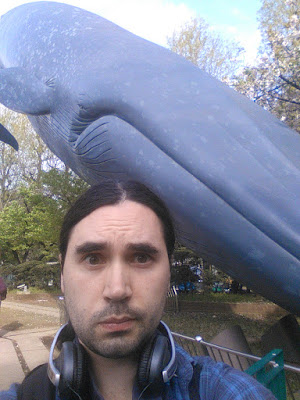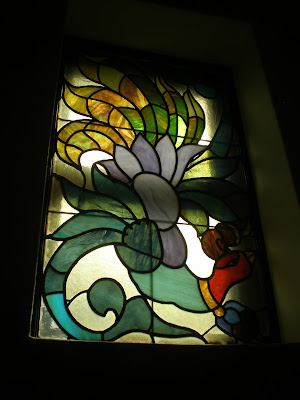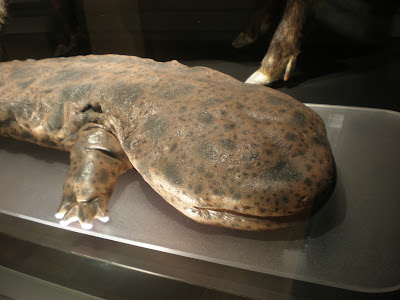The Museum of Science and Nature
The big event of my trip today was 国立科学博物館, the National Museum of Science and Nature. Or the National Science Museum, as it appears to be literally named. I like natural history, a lot, and also science, so the opportunity to do those things in Japanese was obviously tempting.

Here it is called the National Museum of Nature and Science. But who am I to quibble at a little inconsistency?

There is a big statue of a whale outside the museum. I honestly couldn't decide whether I thought this was a valiant attempt to alter public perception of whales and inspire the desire for conservation, or a hypocritical celebration of endangered creatures which the government persists in killing under a blatantly false pretence of scientific research when Japanese people rarely touch the stuff, or a purely random event. On the whole I'm inclined to think the museum is probably pro-whale.

Whalefie! I have developed a tragic fondness for ironic selfies, especially where a silly name can be coined.

Moderately interesting building; I found the proportions of the blocks, and the accidental colour contrasts with the green bronze, quite pleasing.
Just to warn you in advance, this post is mostly going to be pictures of cool things and not much musing. If you unaccountably come here looking for stuff I wrote, you'll probably be disappointed.
Inside the museum
Before I got into the museum proper, I found an exhibition of futuristic art by local schoolchildren. Some fun ideas here.

The entrance to the 360-degree cinema. No photos allowed inside! I watched a film on the evolution of humans. It was kind of cool but also weird.

This display is discussing the Japanese Deer Dance, which I'd never heard of but would now like to see. You can find some cool photos at Shishiodori.com and
I found a video. Watch it in high definition, it's much nicer.

This is a model of an early hut. Very similar to ones I've seen in old Celtic sites - probably not suprising, there's a limited set of good ways to solve the same survival problems.

This cabinet contained a selection of skulls dated to different periods of human development, and reconstructions of possible faces. Here we have a Yayoi People skull, dated around 300BC-300AD, the Iron Age in Japan.
The windows of the staircase are very nice. Relatively simple, but stylish. I couldn't capture the look of the light through them, though.

A classic, depressingly common tale of poor ecology. The residents of Oshojima were fed up of the danger of poisonous snakes - which, let's be clear, had as much right as the people to live there - and decided to introduce the Indian mongoose to wipe them out. Good job, guys! The mongoose proceeded to turn its nose up at the prospect of a snake diet, instead plumping for the delicious endemic Amami rabbit and other rare rodents. Due to the extensive spread of the mongoose, these species are now in serious danger of extinction.

A skeleton of Paleoparadoxia tabatai
which looks really cute and I want one as a pet.
A model of a fungal colony, with the visible mushrooms above and a complex web of hyphae below. I think. I don't have the description to hand.

This is not, as I thought, a vampire squid, but a flapjack squid. This species is sufficiently obscure that Wikipedia doesn't even have an entry for the species, which is only found near Japan.

A cheerful, welcoming crocodile (you can tell because there's a notch in the upper jaw where the fourth lower tooth will stick up).

Elephant. They look so odd without basically all of their distinctive features (except being big, of course).
Escape Pod
There were still several floors of the museum left, but by this point I was pretty worn out. I feel like, especially after a morning of walking around, doing a whole museum in a day is usually neither a good idea nor very practical. Instead I headed off to get something to eat.
I normally aim to have something vaguely interesting or insightful to say, but I... don't, really. It's a museum, not greatly different (in the sections I saw) from what you might find in another city in another country. There were no striking cultural aspects I noticed to comment on, and nothing entertaining happened to me. And quite honestly, I'm pretty tired right now so not in a state to really work at coming up with something. So... this is all you're getting. Sorry.
Afterthoughts
If you like this sort of thing, the Museum is definitely worth a visit. You will need a reasonable level of Japanese to appreciate a large proportion of the exhibits, though in fairness models and skeletons of cool animals are a universal language. There are audio guides available, which I didn't bother with, partly out of laziness and partly because I felt it wasn't necessary for what I'd be looking at. It also has a cafe, which I didn't feel like visiting at the time; like most museum cafes it looked a bit fancy and a bit pricey, but otherwise good.































No comments:
Post a Comment